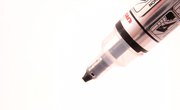
Although you might use permanent markers everyday, you are likely hard-pressed to explain how they work. All markers contain basic ingredients that make up markers. These ingredients dictate how they interact to deliver a reliable, clean line. Remember that "permanent" is sometimes a misnomer as most markers labeled as permanent are not light-fast unless they specifically labeled as archival markers.
What Does A Permanent Marker Consist Of?
All permanent markers are, essentially, a hollow plastic tube that is air tight, save for a single opening at one end. This tube encases a long stick of porous, sponge-like material, which protrudes slightly out of the opening (the tip of the marker). The absorbent material inside the tube is saturated with ink. As ink evaporates or drains from the exposed tip, a siphoning effect draws ink from inside the tube out to the tip. Permanent marker ink is composed of three elements: a colorant, a solvent and a resin.
Colorant
The colorant is a pigment or dye that gives ink its specific color. Whether black, blue, red, neon yellow, pink or any other hue, the colorant is what you actually see when you look at a line made by a permanent marker. The main difference between dyes and pigments is that dyes are water soluble while pigments are generally insoluble in water or non-polar solvents, unless the pigment is ground into very, very fine powder. Because of this property, pigments are usually the preferred colorant for markers, given their resistance to dissolution by humidity or other environmental agents.
Solvent
The solvent is really the key to permanent markers; without this liquid carrier to dissolve and transport ink colorant and ink resin through the sponge via siphoning, markers would not work. Whereas water is a polar solvent, ink solvents must be non-polar to dissolve colorants and resins, which are non-polar. Originally, manufacturers used xyelene as a solvent but switched in the 1990s to less toxic alcohols (like ethanol and isopropanol) as children began to use markers for school. Once liquid ink is applied to paper, the solvent automatically evaporates into the air, leaving only the colorant and resin.
Resin
A glue-like polymer, ink resin ensures that ink colorant "sticks" to paper once the solvent evaporates. If ink were just colorant and solvent, the colorant would turn to dust and fall off the paper as soon as the solvent dried or evaporated. While ink resin is naturally "sticky," the ink solvent keeps it free and fluid inside the marker's sealed plastic tube.
Differences
The biggest difference between permanent and non-permanent markers lies in the ink resin. In permanent markers, the resin tends to be very non-polar--it doesn't dissolve in water at all. So, if ink with this non-polar resin gets on a piece of clothing, your washing machine won't be able to remove the mark. However, dry cleaning (where clothing is washed in a non-polar solvent like acetone instead of water) will dissolve the resin and thus remove the mark. Conversely, non-permanent markers use ink resins which are readily dissolved in water. Additionally, permanent markers may use certain pigments and dyes that do not dissolve in water.
References
About the Author
A Chicago-based copywriter, Andy Pasquesi has extensive experience writing for automotive (BMW, MINI Cooper, Harley-Davidson), financial services (Ivy Funds, William Blair, T. Rowe Price, CME Group), healthcare (Abbott) and consumer goods (Sony, Motorola, Knoll) clients. He holds a Bachelor of Arts in English from Harvard University but does not care for the Oxford comma.
